Understanding Diamond Color and Clarity
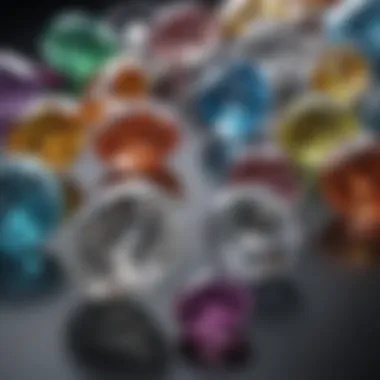
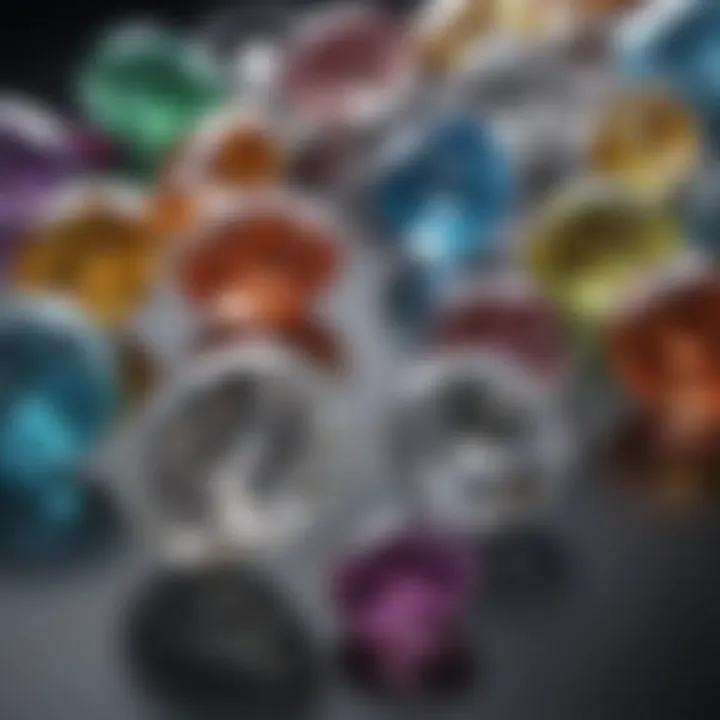
Intro
Diamonds, the epitome of elegance and luxury, have captivated humanity for centuries. Beyond their physical beauty, diamonds hold deep significance in cultural practices, personal milestones, and even historical narratives. Understanding the nuances of diamond color and clarity is pivotal for anyone venturing into the gemstone market, whether they are collectors, designers, or simply enthusiasts.
In this article, we will explore the intricate grading systems that govern the evaluation of diamond quality. Grasping these concepts not only enhances one’s appreciation for these gemstones but also equips potential buyers with the knowledge to make informed decisions. Let’s embark on this journey into the dazzling world of diamonds.
Gemstone Overview
Definition and Characteristics
At its core, a diamond is a crystalline form of carbon, renowned for its unmatched hardness and brilliant optical properties. Typically, diamonds are measured by four key characteristics, known as the "Four Cs": Color, Clarity, Cut, and Carat Weight. Each of these elements plays a significant role in the diamond's overall aesthetic appeal and market value.
- Color: Ranges from colorless to shades of yellow or brown, with colorlessness being the most sought after.
- Clarity: Refers to the presence of internal or external blemishes; more clarity means a higher value.
- Cut: This dictates how well the diamond reflects light, which is essential for its sparkle.
- Carat Weight: Indicates the size of the diamond; larger carats naturally command higher prices.
Understanding these characteristics helps in comprehending the broader spectrum of diamond valuation.
Classification of Gemstones
Gemstones are classified into various categories, primarily based on their composition and formation. Diamonds are classified as precious gemstones, alongside rubies, sapphires, and emeralds. This classification underscores their rarity and desirability in various markets.
There are two subclasses worth noting in the classification of diamonds:
- Natural Diamonds: Formed underground over billions of years.
- Synthetic Diamonds: Created in laboratories, mimicking the natural process.
As we delve deeper into diamonds, particularly color and clarity, it’s essential to grasp their grading and scientific comprehension.
"The quality of a diamond is not just about how it looks, it's about the story it tells and the science that makes it extraordinary."
Historical Significance
Ancient Uses and Cultural Importance
Diamonds have a long and storied history, dating back to ancient civilizations. Initially valued for their hardness, diamonds were utilized as tools in India over 3,000 years ago. However, their allure quickly transcended utility; they became symbols of power and status.
Culturally, diamonds have held significant symbolic weight in various societies, often associated with love and commitment. The tradition of diamond engagement rings, popularized in the late 19th and early 20th centuries, transformed the diamond into an essential part of matrimonial rituals.
Myths and Legends Surrounding Gemstones
Throughout history, diamonds have been shrouded in myths and legends, often believed to possess mystical powers. Some cultures thought diamonds could bring luck or protect against harm. In medieval Europe, diamonds were fancifully thought to hold medicinal properties, capable of curing ailments and dissolving negative energies.
These stories not only highlight the cultural significance of diamonds but also their enduring fascination across generations.
Understanding Diamond Characteristics
When diving into the realm of diamonds, the first important aspect to grasp is their characteristics, particularly color and clarity. These two factors not only define the aesthetic appeal of a diamond but also play a crucial role in its valuation. A deeper understanding of diamond characteristics can empower buyers and sellers alike, guiding decisions and enhancing appreciation for these exquisite gems.
Knowing how color and clarity affect a diamond’s market value is essential for anyone involved in the jewelry business, from collectors to jewelry designers. Color refers to the hue, tone, and saturation of a diamond, while clarity relates to the presence of imperfections or inclusions within the stone. Both characteristics are evaluated using a standardized grading system that provides a benchmark for quality.
This understanding helps buyers make informed choices and ultimately leads to better investments. Additionally, distinguishing between subtle variations in color and clarity can enhance one’s appreciation for natural gems. Whether you’re choosing an engagement ring or expanding a collection, understanding these characteristics ensures thoughtful selections that align with personal taste and budget.
The Definition of Color in Diamonds
Color in diamonds is primarily assessed on a scale that ranges from colorless to shades of yellow or brown. The most prized diamonds are those with minimal color because they allow more light to pass through, resulting in superior brilliance and fire. However, beyond the traditional grading, diamonds can also be categorized as fancy colors, which include pinks, blues, and greens. These variations can command extraordinary prices, reflecting both rarity and desirability.
In general terms, the absence or presence of color in a diamond is vital. When thinking of color grading, it’s essential to consider that even slight differences can significantly influence value. Shoppers should examine diamonds under a controlled lighting environment, as natural light can distort perceived color.
The Importance of Clarity
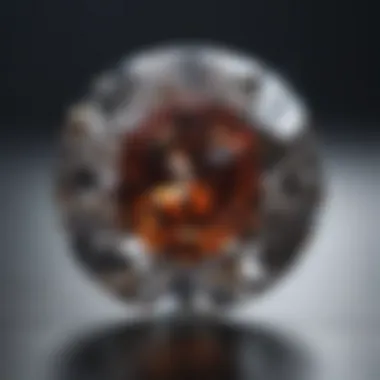
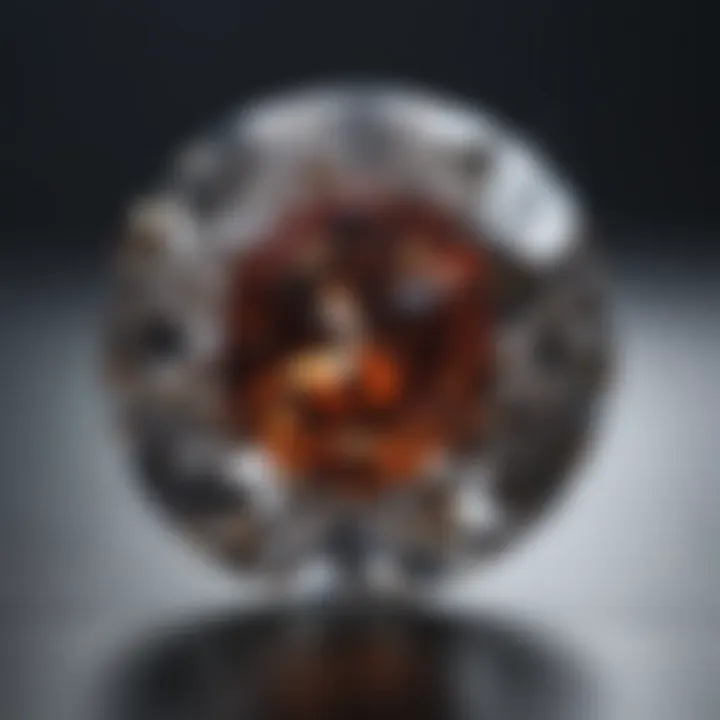
Clarity is another cornerstone of diamond valuation. It refers to the absence of inclusions and blemishes in the gem. Inclusions are internal flaws, like tiny crystals or gas bubbles, while blemishes are surface irregularities, such as scratches or nicks. Diamonds with higher clarity grades are rarer and hence more valuable; a flawless diamond can be astronomically priced, while those with noticeable inclusions may be much more affordable.
The clarity scale ranges from Flawless to Included, and understanding these nuances can help gauge the true quality of a diamond. Buyers should note that while minor imperfections may not be visible to the naked eye, they can still affect the diamond’s brilliance and overall appearance. Consequently, clarity is an important consideration not only for valuation but also for how the stone will perform when worn.
"A diamond's beauty is not just surface deep; it's about the story that lies beneath the surface."
In summary, understanding diamond characteristics gives insight into the factors that contribute to a diamond's value. By honing this knowledge, enthusiasts, collectors, and professionals in the gemology field can make decisions that align with both aesthetic desires and financial realities.
The Diamond Grading Scale
Understanding the diamond grading scale is crucial for anyone involved in the diamond trade or simply interested in acquiring a quality gemstone. This scale functions as a universal language within the gemology community, providing a systematic method for evaluating the most significant characteristics of diamonds: color and clarity. Knowing how this grading works can help potential buyers make informed decisions and ensure they are getting value for their money.
The diamond grading scale has a fundamental role, not just in valuation, but also in shaping consumer perceptions. It simplifies the complex world of gemstones into clear, standardized categories. This consistency allows both buyers and sellers to communicate effectively about diamonds, minimizing the potential for confusion and misrepresentation. As anyone in the market for diamonds knows, understanding these grades can mean the difference between purchasing a stone with appreciated quality or overpaying for something that may not meet desired expectations.
Overview of the Grading System
The grading system for diamonds typically involves several key elements, focusing on the Four Cs: Color, Clarity, Cut, and Carat weight. Each of these factors contributes to a diamond's overall appeal and value. The first two, color and clarity, are closely examined during the grading process.
- Color: Diamonds are graded from D (colorless) to Z (light yellow) based on their coloration. The less color a diamond has, the more valuable it is considered.
- Clarity: This measures the presence of inclusions or blemishes within a diamond. The fewer imperfections, the higher the clarity grade.
These assessments are performed under controlled conditions using appropriate lighting and magnification, with the diamond being viewed from multiple angles to ensure a comprehensive evaluation. Grading reports are essential documents that detail the assessment, often issued by reputable organizations.
The GIA Grading Criteria
The Gemological Institute of America, widely known as GIA, is one of the most respected entities in the world of gemology. Their grading criteria set the standard for evaluating diamonds, having developed a reliable, objective system that is followed globally. The GIA employs a rigorous process in evaluating both color and clarity, ensuring accurate and unbiased outcomes.
- Color Grading: GIA's color grading scale ranges from D to Z, assessing subtle differences in tint. The nuances between neighboring grades can often be imperceptible to the untrained eye, making expertise in this area particularly valuable.
- Clarity Grading: GIA clarity grades range from Flawless (no inclusions visible under 10x magnification) to Included (inclusions visible to the naked eye). Each grade considers the size, nature, position, and number of inclusions affect the stone's transparency and overall appearance.
The importance of this rigorous standard is to avoid subjective interpretation, providing buyers with confidence in their purchases. A GIA certification often acts as a signal of quality and value, making it highly sought after by discerning consumers.
"An informed buyer is a confident buyer; understanding the grading system is the first step in making a wise investment in a diamond."
Color Grading in Detail
When delving into diamonds, understanding color grading is essential. The hue of a diamond significantly affects its allure and value. Grading color isn’t just about identifying the visible spectrum; it’s a meticulous process that involves categorizing diamonds based on subtle differences in color. Knowing how diamonds are graded can greatly enhance a buyer's confidence and appreciation for these gemstones.
Understanding the Color Scale
The color scale for diamonds typically ranges from D (colorless) to Z (light yellow or brown). Each increment represents a minute change in color, often undetectable to the untrained eye. This scale is paramount when assessing the beauty and worth of a diamond. Jewelers and gemologists use specialized lighting and viewing conditions to ensure they are accurately perceiving the diamond’s color. In this environment, small nuances become more evident.
Some dealers also employ terms like "near colorless" and "fancy color" to categorize diamonds that fall outside the typical D-Z scale. This nuanced grading helps buyers make informed choices, catering to both aesthetic preferences and budget considerations.
Categories of Color in Diamonds
Colorless
Colorless diamonds are often seen as the epitome of quality. A D-grade diamond, for instance, is completely devoid of any tinting, which allows it to reflect light beautifully with maximum brilliance. This quality makes colorless stones highly sought after. Many people aspire to own a colorless diamond because it can symbolize purity and sophistication. One downside is that they tend to carry a premium price tag, making them a considerable investment.
Near Colorless
Near colorless diamonds, graded as E or F, exhibit only minute traces of color that are barely distinguishable to most people. In terms of budget, these stones offer a compelling alternative since they often present excellent value while still showcasing much of the fire and sparkle of colorless diamonds. For buyers interested in maximizing their investment, near colorless diamonds can be an appealing choice. They strike a balance between quality and cost, ensuring that the purchase doesn’t break the bank.
Faint Color
Faint color diamonds, such as those rated G through J, have a clear hint of yellow or brown, though it remains subtle. While some may overlook them compared to their more colorless counterparts, these stones can offer unique charm. They may also present opportunities for budget-conscious consumers. The key here is to recognize the unique character that faint color can bring; it can add warmth that some buyers might prefer. It's like the difference between a cool white light and a warm, soothing glow.
Fancy Color
Fancy color diamonds are a fascinating realm of their own. Ranging from vibrant yellows to deep blues, these diamonds are graded based on hue, tone, and saturation. Unlike the D-Z scale, the value of fancy colored diamonds can skyrocket due to their rarity. For instance, a vivid pink diamond can command astronomical prices because of its striking beauty and limited availability. However, it’s essential to note that personal preferences play a huge role here; some might prefer a unique fancy colored diamond over a traditional colorless one, and that’s perfectly valid.
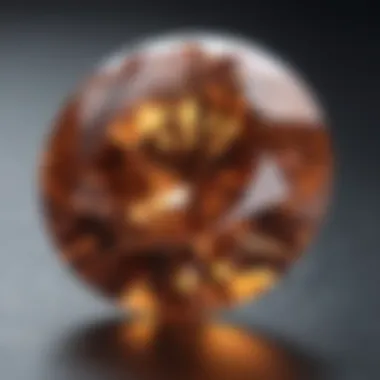
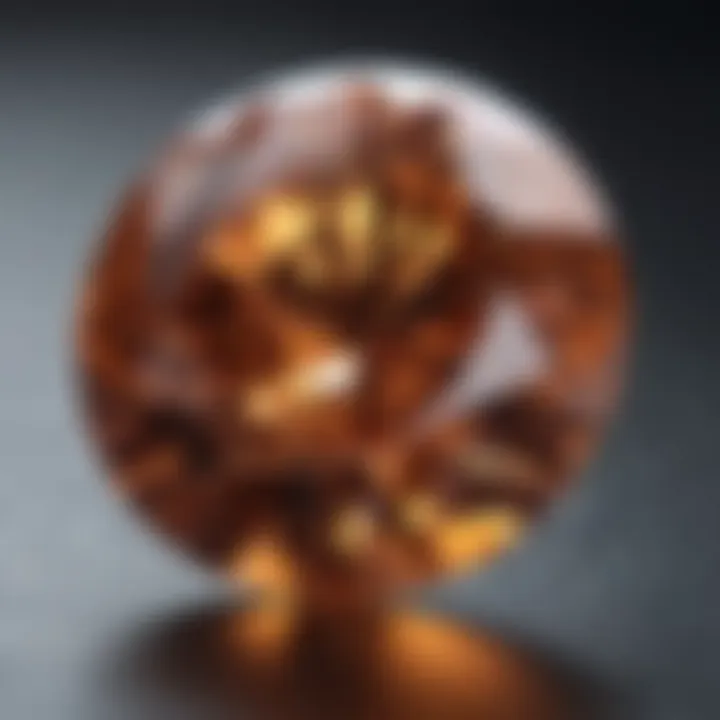
The world of diamond color grading is not just technical jargon; it is an intricate dance of art, science, and personal taste.
Clarity Grading Explained
Understanding diamond clarity is crucial for anyone venturing into the world of gemstones. Clarity refers to the presence of imperfections or inclusions within a diamond, impacting its overall beauty and value. While color often steals the spotlight, clarity holds its own weight in the diamonds’ hierarchy. High clarity diamonds can radiate more light, thus amplifying their brilliance and fire. A diamond with fewer inclusions not only reflects light better but also serves as a status symbol, often referenced as the paragon of perfection within the gem industry.
What Does Clarity Mean?
Clarity is fundamentally about the presence and visibility of internal or external features within a diamond. These features, often called inclusions and blemishes, can vary from minute spots that are almost imperceptible to eye-catching flaws. Jewelers typically assess clarity with a 10x magnification loop, so many consumers might not spot these oddities with the naked eye. However, as with most things in life, the fewer flaws a diamond has, the more desirable it becomes, and consequently, its value rises in the marketplace. Each clarity grade provides a unique understanding of the diamond’s individuality, making it essential knowledge for prospective buyers and collectors alike.
Types of Clarity Grades
Diamonds are classified into various categories based on their clarity, each presenting a different level of imperfections.
Below are the main classifications:
Flawless
Flawless diamonds hold the highest clarity grade. They are completely free of inclusions and blemishes under 10x magnification.
The characteristic that sets flawless diamonds apart is their ability to refract light perfectly, creating unparalleled brilliance and fire.
These diamonds are highly sought after and are often considered one of the best choices for collectors and investors due to their rarity and aesthetic appeal. Adverse aspects include their hefty price tag, making them less accessible for the average buyer.
Internally Flawless
Internally flawless diamonds have no inclusions visible under 10x magnification, but they might have minor surface blemishes. Their beauty shines through, making them a favorable option for many buyers. The advantage of choosing an internally flawless diamond lies in its balance of affordability and aesthetic charm. They represent a remarkable blend of quality and value, but the rare nature of these diamonds can still lead to premium pricing.
Very Very Slightly Included
The classification of very very slightly included diamonds marks them as having minute inclusions that are typically difficult to spot without magnification. This grade strikes a fine compromise between visibility and value. The inclusions, while present, are often so faint that they do little to detract from the diamond’s overall visual appeal. Buyers often find this category an attractive option, as diamonds in this grade offer impressive scintillation without significant sacrifices in price.
Very Slightly Included
Diamonds with this grade may exhibit noticeable inclusions that are easily visible under 10x magnification but are often not seen by the naked eye. This clarity level gives buyers a chance to own a fairly lovely diamond without paying top-dollar prices. They can still feature a decent sparkle, appealing to those seeking value without compromising too much on quality. It involves a careful balance, where the buyer must determine their tolerance for visible imperfections at a reasonable price.
Included
Included diamonds contain numerous inclusions that are visible to the naked eye, often significantly affecting their beauty and overall grade.
While they can be significantly less expensive, many buyers choose to avoid this grade due to aesthetic concerns. However, savvy shoppers might find value in included diamonds if the inclusions are not disruptively prominent. These diamonds can make thoughtful gifts or be used for less formal occasions.
The Impact of Color and Clarity on Value
Understanding the correlation between a diamond's color and clarity with its market value is crucial, especially for those keen on making informed purchases or investments. Each characteristic significantly influences a diamond's desirability, and by extension, its price. So, when evaluating a diamond, it's essential not just to know about these qualities in isolation but to appreciate their combined impact on value.
Market Demand for Various Colors
Color plays a pivotal role in a diamond's allure. While the classic perception often elevates colorless diamonds to the highest pedestal, trends can swing dramatically based on market demand. Various shades can spark interest and create a unique niche in the market. For instance, while most buyers typically gravitate towards traditional white diamonds, fancy colored diamonds—like intense pink, vivid blue, and deep yellow—can fetch astronomical prices.
- Fancy Color Diamonds: These are diamonds that exhibit a noticeable hue. Their rarity often drives up their value. For example, a vivid pink diamond is rare and can command prices well beyond even the highest grades of colorless diamonds.
- Consumer Preferences: Shifting trends often mirror societal influences. As a result of cultural shifts, some consumers are now increasingly drawn to unique colors, prompting dealers to stock more fancy color diamonds.
- Investment Potential: Rare colors are becoming investment vehicles. Investors and collectors often seek diamonds that few can access. Diamonds like the Hope Diamond or the Pink Star reflect how magnificent colors can command a prized position in both aesthetics and value.
The Role of Clarity in Pricing
Clarity is another critical determinant of value. The fewer the blemishes and inclusions, the higher the clarity grade. Buyers frequently see clarity as a reflection of the diamond's overall health and quality. This means diamonds labeled as Flawless command premium prices, while those classified as Included may struggle to find eager buyers.
- Clarity Grades: The difference between clarity grades can lead to substantial price variations. For instance, a diamond classified as Flawless could be 20-30% more expensive than a Very Slightly Included diamond of the same size and color.
- Market Perception: The sparkle of a diamond is more than just about color; clarity affects light performance. A diamond that appears clear and brilliant will always have a distinct edge, particularly within the expectations of high-end jewelry.
- Physical Characteristics: The internal elements found in diamonds, like tiny feathers or crystals, affect not just visuals but potential structural integrity. Therefore, buyers looking to make long-term investments should consider clarity as fundamental for the longevity of their gems.
"Taste in diamonds is subjective, but clarity and color will always dictate their market value. It's essential to stay informed and adapt to trends to make savvy choices."
As a conclusion, recognizing the weight of both color and clarity in determining a diamond's market value is essential for anyone in the diamond buying game, whether for personal enjoyment or long-term investment.
How to Assess Diamond Quality
Understanding the quality of a diamond is crucial for both buyers and sellers in the gem market. Having a keen eye for color and clarity can set one apart when it comes to making informed decisions. The importance of assessing diamond quality lies not only in ensuring value but also in securing satisfaction with the purchase. A diamond represents more than just its physical attributes; it resonates with emotion, significance, and personal taste.
To simplify the assessment process, knowing the tools available and practical tips can make a difference in your approach.
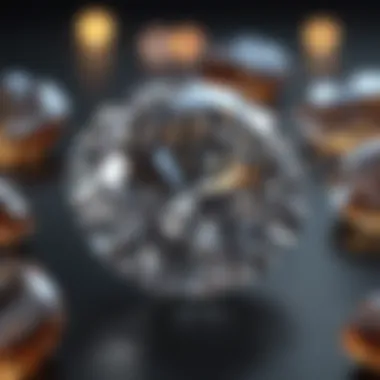
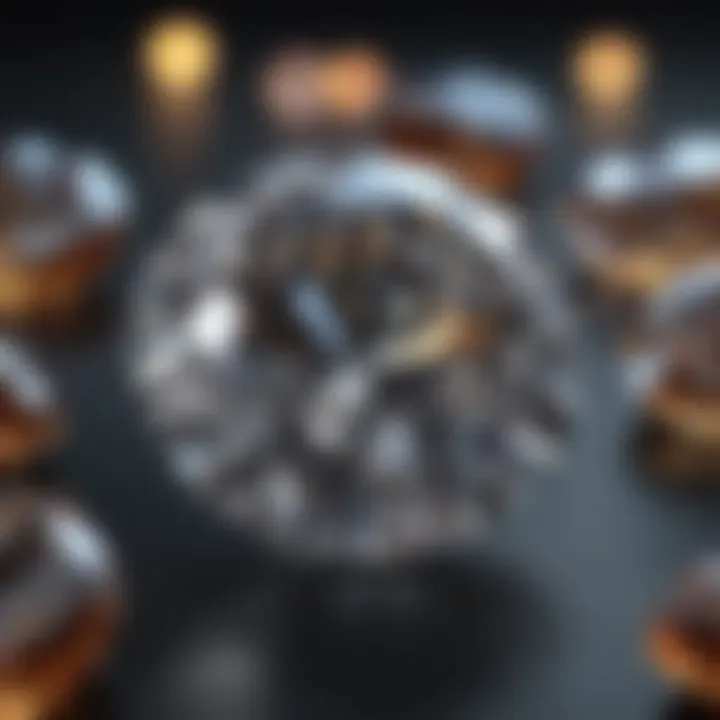
Tools for Evaluation
When venturing into the world of diamond assessment, it’s imperative to arm yourself with the right tools. Here’s a run-down of essential equipment for evaluating diamond quality:
- Loupe: A 10x magnification loupe is indispensable for scrutinizing intricate details. This small yet powerful tool allows you to spot inclusions and flaws that may not be visible to the naked eye.
- Microscope: For a closer look, using a microscope expands your ability to see minute features, unveiling what a loupe might miss. It's often used in more professional settings.
- Smartphone Apps: While not traditional tools, several apps can help measure color and clarity as a quick reference. They offer convenience but are best used alongside other methods.
- Color Grading Master Sets: These sets consist of actual diamonds of various hues used to compare and assess color quality accurately. They act as a reference to determine where a diamond stands on the color scale.
- Gem Tester: A device that identifies a diamond through its thermal conductivity. This tool can help confirm the authenticity of the stone.
Equipped with these tools, one can begin the meticulous task of diamond evaluation with much more confidence and a solid foundation.
Practical Tips for Buyers
Navigating the ocean of diamonds can be overwhelming. However, applying a few practical tips can equip buyers to make well-informed decisions:
- Know the 4Cs: Always remember the basics: Cut, Color, Clarity, and Carat weight. Each factor plays a pivotal role in the diamond's overall quality and value.
- Don’t Rush: Take your time while assessing. A diamond is a significant investment, so it’s worth spending extra moments scrutinizing each aspect carefully.
- Seek Certification: Only purchase diamonds that come with a grading certificate from a reputable lab, such as the Gemological Institue of America (GIA). This ensures that the grading is trustworthy and provides details about the diamond's characteristics.
- Compare Prices: Shopping around can reveal variations in pricing. Different retailers may offer similar stones at different costs, so don’t shy away from comparing.
- Trust Your Instincts: Personal taste plays a large role. If a diamond resonates with you, it’s worth considering, regardless of its technical grading, because ultimately, it should bring you joy.
A diamond should not only shine in terms of its features but also in how it makes you feel.
By implementing these tips, buyers can navigate the often confusing diamond market with increased knowledge and clarity, helping them to feel more secure with their purchases.
Common Misconceptions About Color and Clarity
Understanding the common misconceptions about diamond color and clarity is crucial. Many people approach their diamond shopping journey armed with preconceived ideas that might lead them astray. These beliefs can often skew perceptions and cause unnecessary confusion in an already intricate field. By addressing these issues, one can make more informed decisions, ensuring the investment in a diamond reflects true quality and personal preferences rather than misconceptions.
Dispelling Myths in Diamond Shopping
Diamonds are often wrapped in a shroud of myths and urban legends. One prevalent myth is that a diamond’s size is a direct indicator of its quality. While size certainly makes an impact, it is not the whole picture. In fact, people often overlook how color and clarity can dramatically affect a diamond's brilliance and overall appeal.
- Myth 1: "Bigger means better."
- Myth 2: "All diamonds are identical in quality."
- Truth: A smaller diamond with perfect clarity and ideal color can surpass a larger diamond that lacks those characteristics.
- Truth: Diamonds vary greatly. Each possesses unique traits that influence its desirability and price.
Additionally, some might believe that they can only seek out colorless diamonds. However, this notion neglects the beauty of fancy color diamonds, which can often be more valuable due to their rarity. Furthermore, clarity is sometimes mistaken as the single most important characteristic, but in reality, it’s the balance of all four Cs (Cut, Carat, Color, Clarity) that determines a diamond's overall appeal.
Wading through these myths can be tricky, but with proper knowledge and understanding, shoppers can uncover true value.
Clarifying Misunderstandings Regarding Grading
Grading diamonds is no simple task, and this leads to several misunderstandings about how diamonds are assessed and categorized. Grading systems, including those from reputable institutions like the GIA, utilize specific criteria to classify each diamond. A common misunderstanding is that grading is purely objective— a matter of checking boxes on a form.
- Reality of Grading: Grading incorporates subjective elements. Two gemologists may evaluate the same diamond differently, particularly when assessing clarity. The human element in diamond grading can lead to variances that buyers might not anticipate.
- Transparency in Grading: Unlike how many believe, grading results are not universally standardized across all dealers. Different institutions and jewelers may have varied grading practices and terminologies, which adds another layer of complexity.
This inconsistency can create confusion for buyers who are trying to compare diamonds across different sellers. One diamond labeled as "Very Slightly Included" at one retailer may not carry the same implications as it does at another. Thus, it’s beneficial for consumers to delve deeper into the grading reports and understand the specifics rather than merely accept labels at face value.
"Understanding the nuances of diamond grading is key to making a wise purchase. A well-informed buyer is a powerful buyer."
As we progress in our exploration of diamonds, having clarity on common misconceptions can empower buyers, ensuring they not only appreciate the intrinsic beauty of diamonds but also navigate the marketplace with confidence.
Future Trends in Diamond Evaluation
The realm of diamonds is ever-evolving, much like the values and perceptions surrounding them. Understanding Future Trends in Diamond Evaluation is crucial for gem enthusiasts, collectors, and jewelry designers who wish to stay ahead in a competitive market. As technology advances and buyer preferences shift, those within the diamond industry must adapt to keep pace. Below, we unravel two significant areas that are shaping the future: technological advances and shifts in consumer preferences.
Technological Advances in Grading
In today's digital age, technology is profoundly altering the way diamonds are graded and evaluated. Precision is now the name of the game, driven by high-tech equipment and innovative methodologies. Here's a look into how these advancements impact the diamond grading landscape:
- Spectroscopy and Imaging Techniques: New tools like spectral analysis offer a window into the internal structure of diamonds. Spectroscopy enables gemologists to identify color grades more accurately and understand the diamond's uniqueness at a molecular level. Advanced imaging technologies provide detailed visuals, allowing for precise assessment of clarity.
- Artificial Intelligence Integration: AI is gradually being incorporated into diamond grading systems. Machine learning algorithms analyze thousands of diamonds, ensuring consistent grading standards and minimizing human error. This not only enhances reliability but can also streamline the grading process, making it quicker and more accessible to consumers.
- Blockchain for Provenance Tracking: With rising concerns about ethical sourcing, blockchain technology is now being utilized to authenticate diamonds. Each gemstone’s journey can be traced from mine to market, giving buyers peace of mind regarding origin and ethical implications. This transparency is becoming a significant selling point and will shape future consumer trust.
"As technology becomes more embedded in diamond grading, precision and trust in the evaluation process are expected to rise."
Shifts in Consumer Preferences
Consumer preferences are shifting at an unprecedented pace. With millennials and Generation Z stepping into the diamond market, it’s vital for suppliers and retailers to understand their distinct desires. Here are some noticeable trends:
- Increased Demand for Ethical Diamonds: There’s a growing consciousness about the environmental and social implications of diamond mining. Consumers are leaning towards ethically sourced and sustainable diamonds, such as lab-grown options. This shift towards responsibility is reshaping inventory selections in jewelry stores.
- Personalization and Variety: Shoppers nowadays are gravitating towards unique pieces that reflect their personal stories and individual styles. Customizable diamonds with distinct colors and settings are becoming more popular, resulting in an explosion of creativity among jewelry designers.
- Focus on Quality over Quantity: Luxury buyers increasingly prefer fewer, high-quality pieces instead of an array of average diamonds. This trend emphasizes the significance of color and clarity even more in the purchasing process. Educating buyers on grading systems becomes essential to help them make informed choices.







